
Sustainability is a key issue for the 21st century. Exploring different ways that we can live within the ecological limits of our planet is an growing challenge and there are growing signs of stress.
Exploring Sustainability is an introduction to the challenges we face in finding ways that we can live within the ecological limits of our planet.
The information on this page is broken down into bite-sized chunks or themes which have been selected to give an overview of some key issues surrounding sustainability. Each theme begins with a short introduction and is followed by links to related resources and questions for critical reflection. A separate panel featuring the voices of tutors, students and memorable quotations serves as a counterpoint which will broaden discussion.
Why does this matter?
Global climate change, the loss of biodiversity, population growth, and conflicts between unequal social groups raise complex and inter-related issues.
Schools and universities, along with other educational institutions, have animportant role in developing critical and creative thinking about such problems.
Sustainability is sometimes seen as being limited to a few specific subject disciplines such as geography and citizenship. However, such thinking denies its potential to illuminate understanding across all areas of the curriculum.
There are also those who are weary of the sustainability debate and find it both dull and repetitive. Imaginative approaches which harness students’ creative responses have the potential to reverse this mindset.
Who is this resource for?
Exploring Sustainability is intended for those involved in higher education, particularly university tutors and their students.
- It aims to raise questions rather than to provide answers.
- It does not purport to offer practical teaching advice, nor does it concern itself with issues to do with management or institutional change.
- It is positioned within current European thinking and reflects the concerns of Western industrialised countries.
It has been written by Stephen Scoffham and is based on research, scholarship, and the practical experience of teaching about sustainability in higher education.
How do I use this resource?
The sections are broken down into a suggested order of reading, but you can skip back and forth, or just jump to a section that interests you with the navigation links on the right.
You don't have to read this all in one go - you may want to take it one section at a time, and then give yourself some time to ruminate on it, explore some of the questions that it raises for you, and come back to resume your journey on another day. You may prefer to work through it all in one or two sittings, and take some notes, and then use it as a launching off point for your own conversations, studies or research.
If you are a tutor wanting to embed sustainability into your curriculum, you may want to use this resource alongside the other resources that are on this page.
Definitions of Sustainability

Sustainability is a complex notion that has many definitions.
The word 'sustainability' started coming into popular usage in the 1960s as people in industrialised countries began to appreciate that the effects they were having on their surroundings had global implications. It is a term that is used in a wide variety of ways.
One approach is to think of sustainability as having three dimensions ‘economy’, ‘society’ and ‘environment’, which combine in different ways at a range of scales from the local to the global. Those who favour ecological perspectives see sustainability as being an all-embracing context that frames all our other activities (Figure 1).
Others place equal emphasis on each of the three dimensions which they believe are complementary (Figure 2). However, it is also contended that sustainability has more than three dimensions and that factors such as power, politics and spiritual awareness are essential components of a more mature understanding.
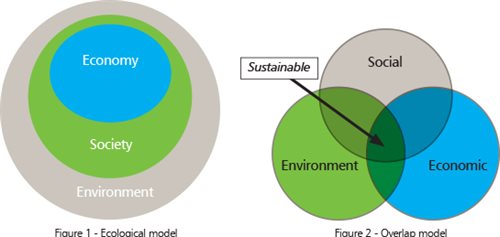
Sustainability is often associated with development. Sustainable development was memorably described in the Brundtland Report (1987) as 'development that meets the needs of the present without compromising the ability of future generations to meet their own needs.'
By considering the needs of future generations, the Brundtland definition sets sustainability firmly in a forward-looking time frame. It draws on two fundamental concepts - the notion of needs and the notion of limitations. Striking a balance between these two concepts raises questions about justice and equity and reveals some of the hidden tensions and contradictions that lie beneath the sustainability agenda.
Things to do now
1) Find out more about different approaches to sustainability by watching the short clip below.
2) Explore the Academy for Sustainable Futures pages to find out more about current projects.
3) Watch Arjen Wals: Quality of Life: https://www.youtube.com/embed/iqB4ryiS4cY
Discussion
-
Does it matter that there are so many different ways of thinking about sustainability?
-
To what extent do you think we have a responsibility to the future?
Different Voices
"Sustainable development involves a confusing discussion about where you fit into the bigger picture and the future of the world.
- Group of trainee classroom assistants
"The definition that refers forward to future generations (ie looking after the biosphere including human beings and their needs) is a good one as I think that consumer capitalism is unsustainable."
- Tutor in Initial Teacher Education
"I think sustainability is about living in the present so as not to foreclose on the future. This relates principally to living systems and has implications for individuals, communities, societies and the global community as they inter-relate with the natural world on which they are irreducibly dependent."
- Chaplain
Readings
Klein, N. (2014) This Changes Everything, London: Penguin
Thompson. E. et al. (2019) Letters to the Earth, London: Collins
Vane-Wright, R. (2009) ‘Planetary Awareness: Worldviews and the Conservation of Biodiversity’ in Kellert, S. and Speth, G. (eds.) The Coming Transformation, Yale: Yale School of Forestry and Environmental Forestry.
Planetary Limits

The Earth has a finite carrying capacity.
Scientists are providing increasingly compelling evidence of environmental change and stress. Around the world glaciers and ice sheets are retreating, the overall health and diversity of wildlife is declining, human numbers are increasing and natural resources are over-exploited. If these trends continue unchecked there is an increasing danger of long term social and economic catastrophe.
Does it make sense to talk about the environment crisis? The Gaia theory proposed by James Lovelock highlights how natural systems are self-regulating and will always find a balance. Other people argue that technology will solve environmental problems and continue to enhance our standard of living.
Trying to make predictions is fraught with difficulties. However, current levels of consumption already exceed the carrying capacity of the planet. The resources we use in a year take eighteen months to regenerate.
Ultimately, thinking about sustainability challenges us to consider our relationship with nature. Do we stand apart from nature or are we part of it? It also alerts us to our responsibility to the future. Will the Earth that we pass on to our children be significantly poorer than the one we ourselves inherited? The way that we answer such questions will draw on notions of equity, inclusion and social justice.

Things to do now
1) What points do you think the following cartoons are making? In what way do they add to your understanding?
Economic Growth
Climate Change
2) Watch this cartoon about how environmental degradation may have happened on Easter Island. https://www.youtube.com/embed/15jrEQegcI8
3) Now find out how Hans Gosling thinks about development by watching the following video: https://www.youtube.com/embed/6sqnptxlCcw
Discussion
-
Do you agree that the environment is fundamental to humanity? If so, why?
- Do you think that experiencing nature directly can have a positive impact on our thinking?
Different voices
"The relationships between people and wildlife are of great concern if we believe that biodiversity has value in maintaining an ecologically balanced world for generations to come. This need for co-existence brings amazing opportunities as well as challenges, which pervade the realms of many disciplines."
- Tutor in Geography and Life Sciences
"Sitting around the fire making and preparing the food made me realise just how important food and fire are to humanity in the bigger sense. This is the bigger picture which provides the context for why the environment is so fundamental to humanity."
- Childhood Studies tutor reflecting on Forest School training
Readings
Hicks, D. (2017) A Climate Change Companion, Chepstow, UK: Teaching4abetterworld
Lovelock, J. (2010) The Vanishing Face of Gaia, New York: Basic Books
Rockström, j. and Klum, M. (2015) Big World Small Planet, Stockhom: Max Ström Publishing
WWF (2018) Living Planet Report: Aiming Higher – Summary Report
Making Connections

Learning about the environment involves learning about ourselves and others.
Sustainability is about making connections. It involves finding out about oneself as well as learning about other people and places. People are linked to the past through history, culture, religion and beliefs. They are connected to different parts of the world through travel, economics and geography.
However, the way that we live our lives is also fundamentally informed by the way that we interpret our experiences. Time, space and imagination can be combined in complex ways to create narratives which have a sense of meaning and purpose (Figure 3).
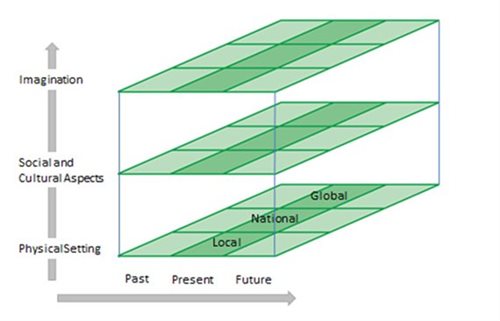
Figure 3: Notions of time, space and culture combine in complex ways to create narratives that drive our actions.
The idea that sustainability involves finding out about oneself might at first seem surprising. However, if sustainability is viewed as a mindset then the logic becomes apparent. One of the consequences is that there are no easy solutions to sustainability issues. Actions that address immediate problems need to tap into deeper thinking if they are to have lasting impact.
Things to do now
1) Read this extract from an article by Andrew Motion on the English countryside. What is it that Andrew Motion values so much about the English countryside?
"I have long believed the countryside is our greatest communal masterpiece. The value of that phrase, for me, is twofold. Firstly, within it lies the idea that the countryside belongs to all of us, not just to those who materially own it. Secondly it retains the idea of beauty, whilst being realistic about how this marvellous thing came into being. An innocent eye might look at the English countryside and think that it is natural beauty incarnate but of course, in reality it’s the result of hundreds of years of farming, husbanding, cropping, wood-planting, hedge-building and other human interactions with the land. We appear to be looking at something extremely complex and deliberated something that we, and the people who before us on this particular bit of Earth, have made.
So what makes our countryside and green spaces so valuable? Anyone who has stood in the midst of a beautiful landscape and felt something understands the answer to that, but finding words for it can be difficult. One of my own favourite landscapes is the great beautiful curve of the East Anglian coast as it sweeps up towards Norfolk. For me, the area around Blakeney and Holkham is one of the most beautiful parts of the world. Its loneliness and its liminal quality are undoubtedly part of the charm. If someone asked me what was so special about that landscape, I would respond in a similar way I might if asked what a good person looked like which is to say there are a lot of good things happening at the same time. It has got something to do with shape, it has something to do with sound (or lack of it); listening to natural rather than person-made sound. It has also something to do with time. A great landscape conveys an idea of fixity and transcience in the same blink of an eye. Fixity because that particular place will be more less like that tomorrow; transcience because the day after the day after tomorrow, it may not look quite that so we must pay attention.
In addition to these qualities, when we stand there and feel connected to the land, we are also using it as a king of canvas onto which we paint our own hopes, delights and even perhaps our own fears and disappointments because looking at a landscape can help us cope just as much with those as it can release our delight in things. I think that was what Edmund Burke was talking about when he wrote on the passion, astonishment and terror of the sublime. The countryside exists as a real place, of course and one with many practical uses including feeding and sheltering us but we are also forever transposing onto it the things that are inside us.
Even though 80% of us now live in urban areas, we are fundamentally rural animals. The countryside is where we have come from as a species and our connection with it is absolutely profound and primitive. You need only look at the tremendous richness of environmental and landscape writing at the moment, certainly in the spheres of poetry and non-fiction, to realise what a vital part of our culture it continues to be."
Countryside Voice (Summer 2013) pp10-11
2) What are the different connections suggested by this video of sea birds at Midway Island? https://www.youtube.com/embed/ENOyss0XMbk
3) What do you think about the links between language and biodiversity suggested in this article?
As forests are cleared and species vanish, there's one other loss: a world of languages - John Vidal for The Guardian, 2014
Discussion
- Apart from making multiple connections, what else do you think contributes to a sustainability mindset?
- Explore how you think the notion of social capital applies to sustainability.
Different voices
Here are three responses to a residential field course:
"I came back feeling revitalised and aware of connections, not only between people and the natural world, but also between sustainability issues."
- Psychology student
"I am more concerned and conscious of our role in society and the impact we have in the immediate and wider world. I feel I have a much more open mind about how sustainability can be interpreted across many different areas and applied in any different ways."
- Trainee teacher
"For me it was one of the highlights of the last ten years I have worked at the University. It was an opportunity to talk to people across Faculties. I found that so rewarding because it’s about building social capital within your own institution - And it was fantastic getting to know like-minded people."
- Tutor in Community Nursing
Readings
Capra, F. and Luisi, P. (2014) The Systems View of Life, Cambridge: Cambridge University Press (see especially Chapter 17 'Joining the Dots')
Louv, R. (2008) Last Child in the Woods, New York: Algonquin (see especially Part VII To Be Amazed)
Rowson, J. (2019) ‘Bildung in the 21st Century – Why Sustainable Prosperity Depends Upon Re-imagining Education’, Centre for Understanding Sustainable Prosperity (CUSP) Essay Series
New Mindsets

New problems and challenges require new solutions.
Debates about sustainability and the environment do not usually lead to definite conclusions. Indeed they are likely to be ambiguous, contradictory and ill-defined. This has led to new theoretical perspectives which reflect the messiness of the real world.
The importance of networks and feedback mechanisms is now widely recognised both in science and social policy. In a business context, complexity theory has alerted managers to the way organisations operate as living systems. Such approaches have the potential to reveal layers of meaning which tend to be excluded from binary and linear perspectives.
One notion that has proved particularly illuminating is the idea of ‘wicked problems’. Whereas ‘tame problems’ tend to be stable, ‘wicked problems’ are ill-defined and ambiguous. They are characterised by unexpected feedback and complex connections and are often associated with strong moral, political or professional purposes.
A further dimension to ‘wicked problems’ is that they have no clear edges or boundaries. As solutions emerge, they themselves change the nature of the problem. This makes it extremely difficult to compare different strategies or to verifying particular lines of thought. Many sustainability issues appear to have these features (Figure 4).

Figure 4: depicts four simple diagrams of how creativity can lead thinking in new directions. Different examples of how creativity (shown by the bold arrows) can promote new thinking.
Things to do now
1) Discuss how the different types of thinking shown in Figure 1 above might help to resolve the problems shown in this cartoon below.
Joe Heller - Energy Arguments
2) Now watch this video about wicked problems. Is there anything in the video which has changed the way you think about sustainability? https://www.youtube.com/embed/O8FMBBVb71k
3) Watch the video below to find out how levels of public policy are based on different levels of certainty and agreement. https://www.youtube.com/embed/10sTkUlylGI
Discussion
- What are the questions you think we should be asking about sustainability?
- Can you think of any examples where you have developed new thinking about an issue or problem?
Different voices
"I leave (the workshop) with more questions than answers but with increased confidence in asking the questions and a developing framework from which to formulate a response."
- Tutor in Geographical and Life Sciences
"Don't imagine there are magic solutions. Go for co-operation and value diversity."
- Tutor in Media, Art and Design
"Thinking critically around experiences both in university and healthcare practice lends itself to considering the complex 'wicked problems' that affect society. Through this process students are encouraged to consider perspectives beyond their own life-worlds."
- Tutor in Nursing and Applied Clinical Studies
Readings
Lent, L. (2017) The Patterning Instinct, New York: Prometheus Books
Parkin, S. (2010) The Positive Deviant, Abingdon: Earthscan
Rittel, W. J. and Webber, M. M. (1973) Dilemmas in a General Theory of Planning, Policy Sciences 4 155-169
Sustainability Education

Sustainability education is a dimension to learning rather than a traditional subject discipline, and it is significantly different to other areas of the curriculum. There is no established body of knowledge to master, the boundaries are difficult to define and progression and attainment are hard to identify.
What unites sustainability education is a commitment to understanding more about how best to sustain life on Earth in all its different dimensions. This means that sustainability education straddles established subject boundaries rather than fitting within them. It also raises questions about the extent to which education should be drawn into the political arena.
Sustainability education favours participatory approaches to learning as opposed to knowledge transmission. Working co-operatively with other, helps students to develop personal and social skills and to understand that sustainability problems have many dimensions.
The simplest approach is for learners to incorporate new learning within their existing intellectual structures but higher level responses involve greater criticality and new perspectives. Critical engagement helps to guard against tokenism and bias whilst creative engagement has a key role in harnessing motivation.
When they are combined, criticality and creativity have the potential to create a positive synergy in which new ideas are likely to flourish (Figure 5). This is important because the alternative - gloom and despair - is a mindset which is educationally bankrupt.
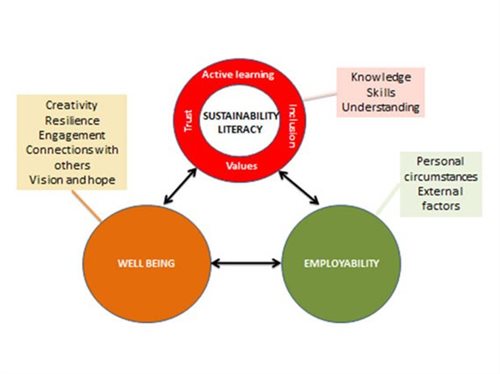
Figure 5: Links between sustainability literacy, well-being and employability in a business context.
Things to do now
1) Read these extracts which express different concerns about environmental education. Do you agree with them?
Critical debate
Bob Jickling argues we should be educating children about sustainable development rather than for sustainable development.
I would like my children to know about the arguments which support (sustainable development) and attempt to clarify it. But, I would also like them to know that sustainable development is being criticized, and I want them to be able to evaluate that criticism and participate in it if they perceive a need. I want them to realize that there is a debate going on between a variety of stances, between adherents of an ecocentric worldview and those who adhere to an anthropocentric worldview. I want my children to be able to participate intelligently in that debate. To do so they will need to be taught that these various positions also constitute logical arguments of greater or less merit, and they will need to be taught to use philosophical techniques to aid their understanding and evaluation of them. They will need to be well educated to do this. For us the task is not to educate for sustainable development. In a rapidly changing world we must enable students to debate, evaluate, and judge for themselves the relative merits of contesting positions. There is a world of difference between these two possibilities. The latter approach is about education; the former is not.
Jickling, B. (1992) ‘Why I Don't Want my Children to be Educated for Sustainable Development: Sustainable Belief’ Journal of Environmental Education , 23 (4) 5-8
Social engineering
Frank Furedi contends that the desire to create a better world which permeates the sustainability agenda amounts to social engineering.
There is a crucial difference between socialization and social engineering. Socialization does not merely involve the transmission of values to the younger generation: it proceeds by communicating values which are already held widely by the older generations in society. In contrast, social engineering is devoted to promoting values that are as yet weak, but which its proponents believe are necessary for society to move forward. This approach is sometimes inspired and justified by the conviction that children should be instructed in more enlightened values to create a better world. (p120)
Over the past two decades, schools have become the target of competing groups of policy-makers, moral entrepreneurs and advocacy organisations who wish to use the curriculum as a vehicle for promoting their ideals and values. As a result pedagogic issues are continually confused with political ones. (p128)
Furedi, F (2009) Wasted: Why education isn’t educating , London: Continuum
Academic freedom
Peter Knight, a university vice chancellor, criticises the strategy for sustainable development proposed by Higher Education Funding Council for England (HEFCE) as an assault on academic freedom.
It is one of the most dangerous and pernicious circulars ever to be issued. It represents the final assault on the last remaining freedoms of universities... The issue here is not whether sustainable development is a good or bad idea. It is about the basic rights and responsibilities of universities, and the need to safeguard academic freedom. It is not the job of universities to promote a particular orthodoxy; it is their role to educate students to examine critically policies, ideas, concepts and systems, then make up their own minds.
1) Knight, P. (2005) ‘Unsustainable Developments’, The Guardian , 8 February
2) Find out why Ken Robinson thinks there is a need for a new educational paradigm. Discuss how the criticisms which Ken Robinson levels against formal education apply to teaching and learning about sustainability. https://www.youtube.com/embed/zDZFcDGpL4U
Discussion
- Do you think education always has to be 'relevant'?
- What types of teaching do you find help you to learn best?
Different voices
"Historians are often seen as trapped behind piles of dusty books. We wanted to work with our students to develop skills for their future careers."
- Professor in Early Modern History explaining her vision for a community engagement project
"Talking gets you to say things you didn’t know you knew."
- Student reflecting on participatory learning
"I wanted to create learning experiences that are meaningful and have significant value to students’ personal and professional lives. I also wanted to build on my own earlier experience of implementing enquiry-based learning and education for sustainable development projects."
- Business School tutor's rationale for new course
Readings
Scoffham, S (2019) ‘How Can We Learn to Live Within Planetary Limits?’ in Hammond, S. and Sangster, M. (eds.) Perspectives on Educational Practice Around the World, London: Bloomsbury
Worldwatch Institute (2017) EarthEd: Rethinking Education on a Changing Planet, Washington: Island Press (see especially Chapter 1 by Erik Assadourian)
Values
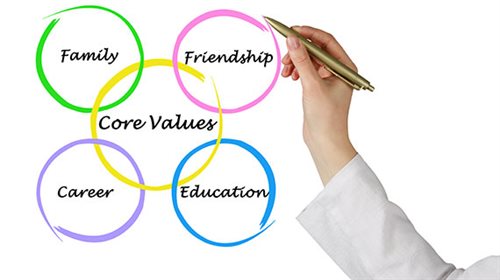
Exploring sustainability and the environment challenges us to acknowledge our values.
The growth of human numbers and the huge expansion of industry and technology since the Industrial Revolution mean that for the first time in history we now have the power to fundamentally alter the balance of life on Earth.
How we respond to this challenge is a moral question. If we continue to use resources and go on polluting our surroundings as at present the impact is likely to be severe. Sustainability thus raises questions about our responsibility to future generations as well as about our relationship with nature (Figure 6).
The sustainability debate also draws attention to global equity and justice. There are massive inequalities of wealth both between and within nations. Some groups of people tread very heavily on the planet and are profligate with its resources whilst others live their lives trapped in poverty and deprivation.
Learning about the violence and contradictions which characterise life in the twenty first century can be extremely distressing. Such topics need to be approached with care and sensitivity in order not to provoke denial or unnecessary guilt on the part of students. However, they can also liberate energy and powerful creative responses.

Figure 6: Sustainability is one of a number of inclusive values which underpins the curriculum
Things to do now
1) Watch this light-hearted video. Do you agree that values cannot be traded? https://www.youtube.com/embed/I6zpnVW134k
2) Do you think it is really possible to combine making profits with social welfare as Harish Manwani suggests in this TED talk?
Discussion
- Is it possible for educators to explore values without preaching or indoctrination?
- Do you think sustainability is a hopelessly idealistic notion?
Different Voices
"We need to consider difficult questions and seek solutions that are socially and morally just. The greater good considers links between past, present and future."
- Tutor in Media, Art and Design
"We talk about values but in this course we have met people in whom the values reside. I am leaving feeling hopeful and inspired by you all."
- Tutor in Initial Teacher Education
Readings
Jordan, K. and Kristjánsson, K. (2017) ‘Sustainability, virtue ethics, and the virtue of harmony with nature’, Environmental Education Research, 23:9, 1205-1229
Moltman, J. (2012) Ethics of Hope, Minneapolis MN: Fortress Press (see especially Chapter 9 Ecology)
Schwartz, S. H. (2012) ‘An Overview of the Schwartz Theory of Basic Values’ Online Readings in Psychology and Culture
World Citizens
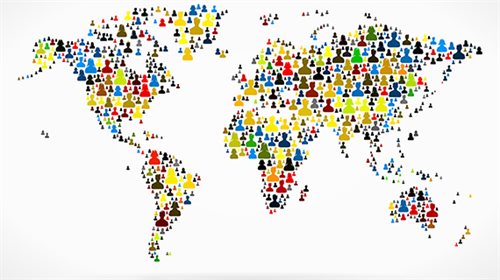
International agreements are one way of addressing environmental issues.
The Antarctic Treaty, signed in 1959, was the first major international agreement aimed at protecting the natural environment (Figure 7).
This was followed by the Montreal Protocol (1987) which phased out the production of gases which were depleting the ozone layer. Since then governments around the world have tried to co-operate on other environmental issues. The Rio de Janeiro Earth Summit (1992) was a landmark event which laid down principles for partnerships on the environment and development. The Kyoto Protocol (2008) and the Paris Climate agreement (2015) built on these achievements by establishing targets designed to limit carbon emissions and keep global warming below two degrees centigrade.
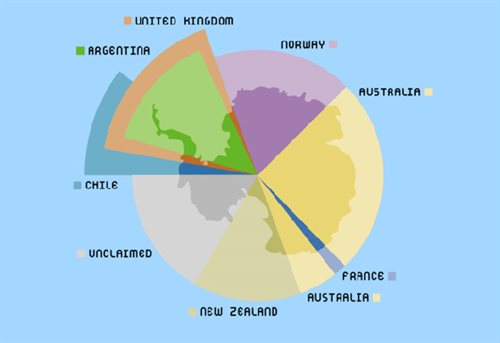
Figure 7: Twelve nations signed the Antarctic Treaty in 1959, since when it has been renewed and extended several times.
Governments and international organisations have the power to pass laws to protect the environment but depend on political support. They are also strongly influenced by business interests. In an economic system where the natural world has no particular monetary value, the problem is that measures to protect the environment are often not given the priority they deserve.
The growth in market forces over recent years has made matters worse as transnational corporations have huge power. Some people think that the laws which require businesses to make money in order to pay shareholders need to be changed. They argue that the wealth that businesses create should also be shared amongst workers, local communities, governments and future generations.
Consumer campaigns are one way to change economic and political priorities. For example, when public opinion is mobilised, as in the case of plastic waste, it can have a big impact. Here again, though, the support of government is crucial. International governance is thus crucially important to the sustainability agenda.
Things to do now
Read the preamble to The Earth Charter and discuss what you think about it.
"We stand at a critical moment in Earth's history, a time when humanity must choose its future. As the world becomes increasingly interdependent and fragile, the future at once holds great peril and great promise. To move forward we must recognize that in the midst of a magnificent diversity of cultures and life forms we are one human family and one Earth community with a common destiny. We must join together to bring forth a sustainable global society founded on respect for nature, universal human rights, economic justice, and a culture of peace. Towards this end, it is imperative that we, the peoples of Earth, declare our responsibility to one another, to the greater community of life, and to future generations.
Earth, Our Home
Humanity is part of a vast evolving universe. Earth, our home, is alive with a unique community of life. The forces of nature make existence a demanding and uncertain adventure, but Earth has provided the conditions essential to life's evolution. The resilience of the community of life and the well-being of humanity depend upon preserving a healthy biosphere with all its ecological systems, a rich variety of plants and animals, fertile soils, pure waters, and clean air. The global environment with its finite resources is a common concern of all peoples. The protection of Earth's vitality, diversity, and beauty is a sacred trust.
The Global Situation
The dominant patterns of production and consumption are causing environmental devastation, the depletion of resources, and a massive extinction of species. Communities are being undermined. The benefits of development are not shared equitably and the gap between rich and poor is widening. Injustice, poverty, ignorance, and violent conflict are widespread and the cause of great suffering. An unprecedented rise in human population has overburdened ecological and social systems. The foundations of global security are threatened. These trends are perilous—but not inevitable.
The Challenges Ahead
The choice is ours: form a global partnership to care for Earth and one another or risk the destruction of ourselves and the diversity of life. Fundamental changes are needed in our values, institutions, and ways of living. We must realize that when basic needs have been met, human development is primarily about being more, not having more. We have the knowledge and technology to provide for all and to reduce our impacts on the environment. The emergence of a global civil society is creating new opportunities to build a democratic and humane world. Our environmental, economic, political, social, and spiritual challenges are interconnected, and together we can forge inclusive solutions.
Universal Responsibility
To realize these aspirations, we must decide to live with a sense of universal responsibility, identifying ourselves with the whole Earth community as well as our local communities. We are at once citizens of different nations and of one world in which the local and global are linked. Everyone shares responsibility for the present and future well-being of the human family and the larger living world. The spirit of human solidarity and kinship with all life is strengthened when we live with reverence for the mystery of being, gratitude for the gift of life, and humility regarding the human place in nature.
We urgently need a shared vision of basic values to provide an ethical foundation for the emerging world community. Therefore, together in hope we affirm the following interdependent principles for a sustainable way of life as a common standard by which the conduct of all individuals, organizations, businesses, governments, and transnational institutions is to be guided and assessed charter."
Discussion
- Why do governments find it so hard to stand up to business interests?
- How can international agreements be enforced?
Different Voices
"I am citizen, not of Greece or Athens, but the world."
- Socrates (Philosopher)
"The new world order that is in the making must focus on the making of a world democracy, peace and prosperity for all."
- Nelson Mandela (Politician)
"Never doubt that a small group of thoughtful, committed citizens can change the world; indeed, it’s the only thing that ever has."
- Margaret Mead (Anthropologist)
Readings
Kelly M. (2003) The Divine Right of Capital, San Francisco, CA: Berrett-Kochler
Goodman, M. and Thornton, J. (2017) Client Earth, London: Scribe
Thunberg, G. (2019) No One Is Too Small to Make a Difference, London; Penguin
Global Goals

The United Nations Sustainable Development Goals are a universal plan to end poverty, protect the planet and ensure global peace and prosperity.
The United Nations Sustainable Development Goals (SDGs) were agreed in 2015 after several years of complex negotiation.
They provide a common plan to address some of the most pressing problems facing the world today. There are 17 goals covering challenges ranging from poverty, climate change and conflict. Each goal is linked to a set of measurable targets to be achieved by 2030.

Figure 8 - The Sustainable Development Goals set out an ambitious agenda for creating a better world.
The Sustainable Development Goals (SDGs) build on the earlier Millennium Development Goals but are more ambitious in their scope as they attempt to address the root causes of problems. It is also important to note that many of the goals are interconnected. This means that success in one area will depend on tackling issues in another. Everyone is responsible for implementing the goals including national governments, businesses, community groups and individuals. It has been estimated that it might cost around 4% of world GDP to achieve them.
The goals have been criticised as being too ambitious, messy and complicated. Furthermore it has proved difficult to devise a set of goals which are appropriate to countries with very different needs. The goals have also been seen as contradictory because they fail to reconcile the tension between economic growth and environmental limits. This perpetuates the shortcomings which are inherent in concept of sustainable development itself. Despite these reservations, getting the nations of the world to agree on a common agenda is itself a remarkable achievement and the SDGs have the potential to become a driving force around which people can coalesce in creating a better future.
Things to do now
Go this site and use the maps to help you make a list of six or more facts about one of the global goals. https://icaci.org/maps-and-sustainable-development-goals/
Different Voices
"There are at least two contradictions at the heart of the Sustainable Development Goals - they are based on growth which is not sustainable in the long term and they fail to challenge the political economy of neoliberalism which has failed to reduce global disparities and climate change."
Faculty of Education Senior Lecturer
"Any attempt to compartmentalize sustainable development into categories will always fall short of the complexities of the real world. However, we need a common language that enables cooperation and action. The SDGs are wide enough to be identifiable worldwide, and yet allow for local interpretation."
University Sustainability Manager
Discussion
Different Voices
“What is the meaning of value, especially in a business context? Is value expressed as the figures on a balance sheet or the effects on an environment and community? Or maybe it’s a combination of the two. And if it is a combination, in what proportions and what do we then have to focus on?”
Business Studies student
“I thought, yeah, I can do this. So I went ‘green’. Eco friendly products. Low juice and anything that’s not harmful. Going from that I don’t eat meat any more. My last meat dinner was Christmas and that was it. My waste has gone to nothing.”